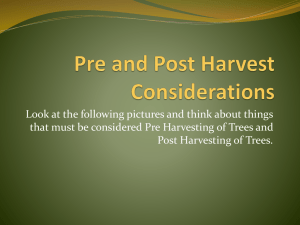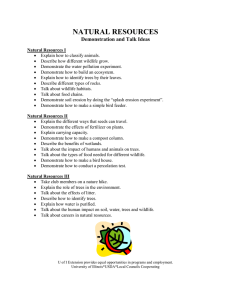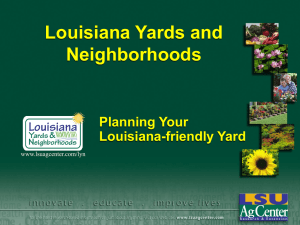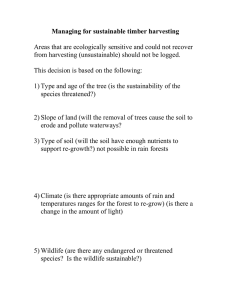Louisiana Yards and Neighborhoods Planning Your Louisiana-friendly Yard
advertisement
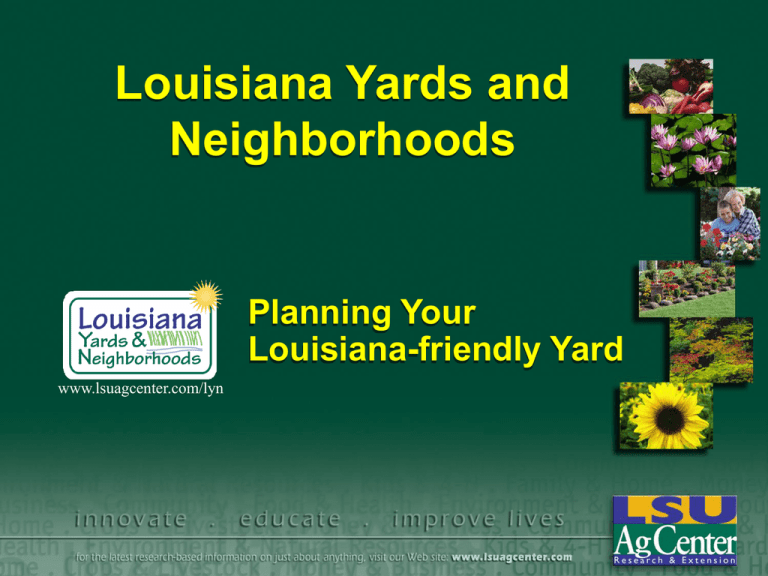
Louisiana Yards and Neighborhoods Planning Your Louisiana-friendly Yard www.lsuagcenter.com/lyn About the LY&N Program • The goal is to encourage homeowners to create and maintain landscapes in ways that minimize environmental damage/impact through educational programs and outreach activities. • Implemented through parish LSU AgCenter extension agents with the support of LSU AgCenter Louisiana Master Gardener volunteers. 7 Interrelated Principles 1. 2. 3. 4. 5. 6. 7. Right Plant, Right Place Water Efficiently Maximize Mulch and Recycle Yard Waste Fertilize Effectively Manage Yard Pests Protect Surface Waters and Wetlands Provide for Beneficial Wildlife Habitat Using the Handbook • It is organized into two sections: – The first introductory section contains background information and will be covered in this training session. – The second offers detailed descriptions of the 7 basic LY&N principles. From Yard to Waterway • Rain that falls on yards, roads and parking lots can wash into waterways or leach into groundwater, carrying pollutants. • In particular, improperly applied fertilizers and pesticides from urban and suburban residential areas can play a role in polluting Louisiana’s waters. The ideal Louisiana-Friendly Yard should reflect the beauty of natural habitats and ecosystems in our state. To be effective, landscapes should be created and maintained by practices that have a low impact on the environment, such as – • Cooperating with pre-existing natural conditions instead of altering them or changing them to suit the desires of the gardener or needs of plants not suited for those conditions. • Conserving water and energy. • Using more native species; and planting native and non-native plants that require minimal water, fertilizers and pesticides in the right growing conditions. Deciduous Holly – Ilex decidua • Small tree about 15’ x 10’ • A deciduous species • Outstanding color on female plants from red fruit when leaves drop • Tolerant of wet to dry conditions Buttonbush Cephalanthus occidentalis • Large shrub or small tree about 10’ x 10’ • Will grow in standing water • Attractive globular clusters of white flowers • Deciduous • Fast growing Wax Myrtle – Myrica cerifera • Large shrub to small tree 12’ x 10’ • Suckers freely • Fruit on female plants good wildlife food • Evergreen • Tolerates wet to dry conditions Swamp Mallow – Hibiscus moscheutos • Shrubby perennial 3’ x 3’ to 5’ x 5’ depending on type • Large, very showy flowers in pink, white and red • Long blooming season • Wildlife nectar plant Cardinal Flower Lobelia cardinalis • Grows 2’ to 3’ • Showy red flowers in early summer • Hummingbird nectar plant • Tolerates shade • Dormant in winter • Moist soil Goldenrod – Solidago spp. • Various sizes from 3’ to 6’ • Brilliant yellow flowers in fall, excellent nectar plant • Spread by rhizomes • Dormant in winter Mist Flower Eupatorium coelestinun • Grows about 2’ x 2’ • Lavender-blue flowers primarily in late summer and fall • Tolerates wet or dry conditions • Spreads by rhizomes • Dormant in winter Louisiana Irises Iris spp. and hybrids • About 2’ to 5’ • Very showy colorful flowers March through April • Tolerant of standing water or drier conditions • Active growth fall through spring • Spreads slowly by rhizome • Choose plants that are appropriate and attractive but also provide environmental benefits. • Tolerate some pest damage in the landscape and focus on gardening techniques that reduce pest problems. Use pesticides only when necessary, follow label directions and choose the least toxic products that will do the job. Creating Louisiana-friendly Yards When designing a landscape more in harmony with the environment, you should consider: 1. Your family’s needs and desires. 2. The conditions of your site. 3. Maintaining a healthy environment. Proper Planning is Critical • Selecting the style – Guides the esthetic aspects of the design – Should be influenced by the architecture of the house • For the LY&N program, informal, naturalistic or ecological (appropriate for Louisiana) styles would be most appropriate. Avoid formal styles since they increase maintenance. Naturalistic Style • Use of native plants and well-adapted introduced plants in a setting that duplicates naturalistic settings, such as woodlands, meadows, ponds, bogs, etc. • Uses natural settings as an example to follow. Informal Style • Relaxed style that makes use of graceful curving lines and naturalistic shapes. • Plants are allowed to develop more natural forms. • Lower maintenance. • Casual building materials and styles. Formal Style • Straight lines and strict geometric shapes • Plants clipped and pruned into architectural geometric shapes • Symmetry • Crisp, formal building materials such as milled, painted wood, brick, flagstones, etc. • Higher maintenance Landscape Design Landscape design combines art and science to create a functional, aesthetically pleasing and ecologically sound landscape that meets the needs of the family and complements the home and other structures. Elements of art, such as color, form, line and texture, interact with design principles of unity, balance, simplicity and focus. Basic Steps In Landscape Design Decide what your landscape should provide for your family’s needs. • Examples of needs include: – Play area – Shade – Privacy – Flowers/color – Outdoor living: patio, deck – Utility/work area, compost – Look at what you need; it will be different for each family. In the LY&N program, other needs might include: • Habitat for wildlife • Food for wildlife • Water for wildlife • Less maintenance • Reduced water runoff Study Your Site • Note the compass directions. • Study light and shade patterns and drainage. • Note existing structures and plantings. • Decide where shade is needed. • Look at views off site; look out windows for views. • See Site Analysis, page 8. Draw a Land-use Plan • Draw up a simple sketch or a scale drawing of the site. • Decide where and how much space will be allocated to particular use or activity areas, such as a patio, vegetable garden, kids play area, work/tool storage area and ornamental plantings. • Use simple circles or “bubbles” to designate location and size of use/activity areas • Play around with several arrangements as you make your decisions. Shape the Spaces • Decide what shape the different areas will have: beds, patio/deck, vegetable garden, work area. • Decide on characteristics plants for particular areas and uses should have – size, growing conditions, flowers, wildlife food, etc. • This is a creative stage influenced by the previous steps and the chosen style. Select the Materials • Select the components that will be used to create the landscape. • Decide on what specific plants to use, depending on preference, purpose, growing conditions, maintenance and value to wildlife. • Decide on building materials for structures, outdoor living areas, fences, walks, etc. SOIL The Foundation of Healthy Plants Improving the Soil • Organic Matter – Compost, aged manure, leaf mold, composted pine bark, soil conditioner • Sand • Fertilizer • Lime • Soil test pH • Measure of the relative acidity or alkalinity of the soil. • Plants are generally adaptable to a wide range of pH values, but will not do well if the pH is too far from what they prefer. • Most plants will do well at pH values between 5.5 and 7.5. • Acid-loving plants generally have the worst problems. • Affects nutrient availability. Compacted Soils • Most common around new construction and in new subdivisions. • Often worse near a newly constructed home, where landscaping is commonly done. • Loosening the soil and adding generous amounts of organic matter or creating raised beds of new soil are options. Deciding Which Plants to Keep • You do not have to leave a plant in a landscape simply because it is there. • But you should consider very carefully before removing plants, particularly trees and shrubs. • If you decide to make changes or redesign your landscape, it’s important to determine what you will keep and what will be removed/replaced. Here are some guidelines. Keep healthy plants that show good form and are in desirable locations. Prune overgrown trees and shrubs if necessary to make them more suitable for the new landscape. Reclaiming overgrown shrubs as small trees. Retain trees with long life spans, such as live oaks, Southern magnolia and baldcypress. Mature, short-lived trees are less desirable, such as water oaks, silver maple and flowering pears. When developing a wooded lot, save clusters of trees and the plants growing beneath them rather than individual trees. Clusters of trees are more resistant to high winds and are usually more attractive. Avoid damaging trees during construction. Proper Tree Planting Look Up • Check for overhead wires, power lines, security lights and buildings that a tree could interfere with as it grows larger. • You must anticipate the MATURE SIZE of the tree when choosing a species and siting it in the landscape. Dig The Hole • The depth of the hole should be slightly less than the height of the root ball. • Dig the hole two to three times the diameter of the root ball. • The sides of the hole should be rough. • The top of the hole may be wider than the bottom of the hole. • See Proper Tree Planting, page 16. Find the Root Flare (Also called the trunk flare or root crown, where the topmost root emerges from the trunk.) • Plant so that the root flare is within 2 inches of the soil surface. • Loosen circling roots in the top half of the root ball. Slice into the root ball. • Choose trees that are not severely root bound. Place the Tree Into the Hole • Remove container-grown trees from the container before placing in the hole. • Position the root flare slightly above soil level. Add more soil under the root ball if necessary. • Make sure the tree is straight. • Remove all string, rope, synthetic burlap, strapping, plastic and other materials from balled-and -burlapped trees. Fill the Planting Hole With Backfill Soil • Thoroughly pulverize the soil removed to create the hole, and use it as is, without additions or amendments such as organic matter, to fill in around the root ball. • Do not compact the soil by pushing or stepping on it. Use a shovel blade to slice down into the soil around the tree. • The root ball should sit slightly above (1 to 3 inches) the backfill soil. Generously Water-in the Tree • Apply about 10 to 20 gallons of water. • This amount will settle the soil and remove air pockets. • Add more soil if necessary. Mulch Around the Tree • Apply mulch out about 4 feet from the trunk of the tree. • The mulch should be in an even layer 2-4 inches deep, and be pulled back slightly from the trunk of the tree. • Constructing a berm around the tree is not recommended. Stake the Tree, If Necessary • Do not place the stakes alongside the trunk and tie the trunk to the stake. This may lead to a weak floppy trunk. • Stakes should be driven into the ground outside of the root ball. • Cushion rope or wire to prevent abrasive damage to the bark of the trunk. • Leave the stakes in place only for about 9 to 12 months. Watering • Most critical the first summer after planting. • Water two to three times a week during hot, dry weather (consider rainfall). • At each watering, apply about 1-2 gallons of water per inch of trunk diameter directly to the root ball. Add water slowly so that it seeps into the root ball. • Watch for drought stress symptoms, such as wilting, scorched leaf edges, poor color and leaf drop. Hire Reputable Professionals • Must be licensed by the state – Horticulture License – Landscape Contractors License – Landscape Architect License – Commercial Pesticide Applicators License, Category 3 Ornamentals and Turf Louisiana Yards and Neighborhoods Planning Your Louisiana-friendly Yard www.lsuagcenter.com/lyn
